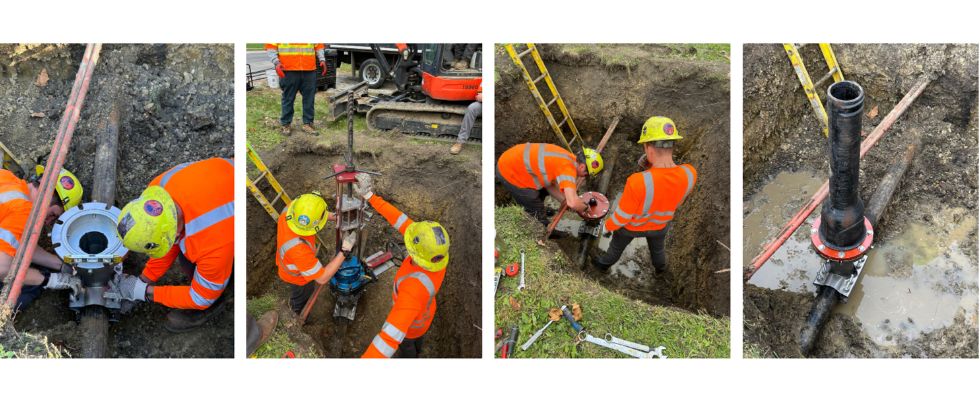
Technology has been advancing rapidly for some time, and most everyday items, like phones, computers or even televisions, require constant updating. However, at the same time, it is unlikely someone would fax a document or use a rotary phone in 2024. People have evolved and adapted to technologies that make their lives simpler, safer and more productive.
Unfortunately, the water industry is slow to adopt advanced technologies and methodologies. Water line maintenance is a prime example of this hesitation. Many water utilities still use a method of line maintenance that is about as old as the invention of the buried water distribution infrastructure—the cut-in method.
Although familiar and routine, the common process of cutting into pipes comes with many complications and hazards. Looking at a routine valve replacement project, there are numerous factors to consider and steps that need to be taken:
- How large does the excavation need to be?
- What is the size of the isolation area, and how many homes, businesses or critical infrastructure will be affected by service disruption?
- Does the repair location create traffic issues, and is a police presence required?
- How many workers are needed to complete the entire project?
- Will heavy machinery, pumps or saws be needed, and will the need for these items require additional personal protective equipment (PPE)?
- Will there be a health or environmental impact from completing the project?
- What are the optics of the situation? Will there be media or user backlash over lost service, traffic or other inconveniences?

Despite having been around for several decades, insertion valves are an ideal solution for many problems that are a byproduct of traditional cut-in methodologies. Unlike traditional repair techniques in a valve replacement project, insertion valves require less time and labor. For most common pipe sizes, a two-person crew can successfully install an insertion valve on a full-flow, in-service line in as little as an hour. This is done without needing large excavations or service disruptions, which avoids service notifications, flushing, repressurizing, re-chlorinating and boil orders.
Unfortunately, the perception and understanding of insertion valves is often stuck in the past. Misconceptions about insertion valves and their use often prevent water utilities from utilizing valve insertion when it would be the ideal solution. Since their invention, insertion valves have undergone significant advancements and are a safer, more productive solution for modern communities. Many of today’s insertion valves:
- Are simple to install. Compared to the time-consuming cut-in methodology, insertion valves are quicker to install and less disruptive. Installing an insertion valve is an easy-to-learn process for water professionals, and well-trained crews can install an insertion valve in as little as an hour.
- Are permanent assets. Modern insertion valves are built to last and are designed to meet a utility’s long-term need for a reliable control point with a lifetime of use.
- Perform like traditional valves. Modern insertion valves meet or exceed traditional valves’ performance requirements. As with any valve properly installed, insertion valves provide reliable and efficient flow control.
- Are not just for emergencies. Though popular for emergency maintenance, insertion valves are ideal for routine maintenance, modifications or expansions. They are perfect for proactive maintenance and assessment, allowing targeted isolation without large service disruptions.
- Are overall more cost-effective. While a traditional valve’s price tag may be less than an insertion valve, the overall cost of purchasing and installing an insertion valve is more economical than that of a traditional valve. The pipe-cutting method is more labor-intensive, which can incur additional costs and extended downtimes. However, by utilizing insertion valves, a utility eliminates 100% of the costs associated with shutdown and can see an average of 40% in savings in terms of labor, equipment and overall project costs.
- Do not impact pipe integrity. For common pipe sizes (4-16 inches), high-quality insertion valves do not sever the pipe, reinforce beam strength or require mechanical restraints, backfill or concrete to operate the valve. This is especially beneficial during emergency repairs.
There have been many advancements in valve insertion technology. However, not all insertion valves are created equally. While many are rated for 250 pounds per square inch (psi) working pressure, some manufacturers continue innovating by utilizing stronger, more corrosion-resistant materials, improved designs and installation procedures and more. It is essential to recognize what features of an insertion valve best fit the project or the user’s specific needs. With the right selection, water utilities can gain a more productive and cost-effective alternative to traditional cut-in valve replacement and line maintenance.
Advancing technologies have raised expectations and increased convenience for everyone. People expect things to be done quickly and with decreased effort. Just as email and file sharing have replaced the need for fax machines, insertion valves are the tools needed for modern communities looking to gain control of their water distribution systems without the disruptions, hassles and costs associated with old-fashioned line maintenance.


